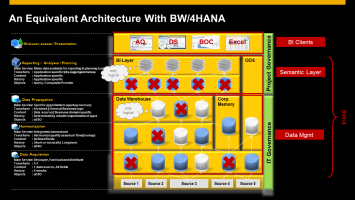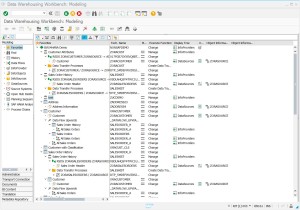
- SAP Community
- Products and Technology
- Technology
- Technology Blogs by SAP
- Data Modeling with #BW4HANA
- Subscribe to RSS Feed
- Mark as New
- Mark as Read
- Bookmark
- Subscribe
- Printer Friendly Page
- Report Inappropriate Content
 One of the most striking differences between BW and BW/4HANA is data modeling. On one hand, there is less but more versatile objects to choose from (see figure 1). On the other hand, there is a new, more intuitive alternative to BW's long standing admin workbench (RSA1), namely the Data Flow Modeler (see figure 2). It shows physical and virtual containers (like DSOs or composite providers) as boxes. Data transformations, combinations, transitions etc. are indicated as directed lines between those boxes. From those boxes and lines it is possible to access the respective editor for those objects. In that way, a DW architect can navigate along the paths that the data take from entering the system towards the multidimensional views that serve as source to pivot tables, charts and other suitable visualisations. This is not only great for the mentioned DW architect but also allows for rapid prototyping scenarios, e.g. when a DW architect sits down with a business user to quickly create a new or modify a given model. Figure 3 shows an example.
One of the most striking differences between BW and BW/4HANA is data modeling. On one hand, there is less but more versatile objects to choose from (see figure 1). On the other hand, there is a new, more intuitive alternative to BW's long standing admin workbench (RSA1), namely the Data Flow Modeler (see figure 2). It shows physical and virtual containers (like DSOs or composite providers) as boxes. Data transformations, combinations, transitions etc. are indicated as directed lines between those boxes. From those boxes and lines it is possible to access the respective editor for those objects. In that way, a DW architect can navigate along the paths that the data take from entering the system towards the multidimensional views that serve as source to pivot tables, charts and other suitable visualisations. This is not only great for the mentioned DW architect but also allows for rapid prototyping scenarios, e.g. when a DW architect sits down with a business user to quickly create a new or modify a given model. Figure 3 shows an example.
 |  |
| Figure 1: Less and more logical objects when architecting a DW with BW/4HANA. | |

Figure 2: The new Data Flow Modeler in BW/4HANA.
 |  |
| Figure 3: The same scenario, once in the traditional admin workbench (left) and BW/4HANA's Data Flow Modeler (right). | |
This blog has also been published here. You can follow me on Twitter via @tfxz.
- SAP Managed Tags:
- BW (SAP Business Warehouse),
- SAP BW/4HANA
You must be a registered user to add a comment. If you've already registered, sign in. Otherwise, register and sign in.
-
ABAP CDS Views - CDC (Change Data Capture)
2 -
AI
1 -
Analyze Workload Data
1 -
BTP
1 -
Business and IT Integration
2 -
Business application stu
1 -
Business Technology Platform
1 -
Business Trends
1,658 -
Business Trends
91 -
CAP
1 -
cf
1 -
Cloud Foundry
1 -
Confluent
1 -
Customer COE Basics and Fundamentals
1 -
Customer COE Latest and Greatest
3 -
Customer Data Browser app
1 -
Data Analysis Tool
1 -
data migration
1 -
data transfer
1 -
Datasphere
2 -
Event Information
1,400 -
Event Information
66 -
Expert
1 -
Expert Insights
177 -
Expert Insights
293 -
General
1 -
Google cloud
1 -
Google Next'24
1 -
Kafka
1 -
Life at SAP
780 -
Life at SAP
13 -
Migrate your Data App
1 -
MTA
1 -
Network Performance Analysis
1 -
NodeJS
1 -
PDF
1 -
POC
1 -
Product Updates
4,577 -
Product Updates
340 -
Replication Flow
1 -
RisewithSAP
1 -
SAP BTP
1 -
SAP BTP Cloud Foundry
1 -
SAP Cloud ALM
1 -
SAP Cloud Application Programming Model
1 -
SAP Datasphere
2 -
SAP S4HANA Cloud
1 -
SAP S4HANA Migration Cockpit
1 -
Technology Updates
6,873 -
Technology Updates
419 -
Workload Fluctuations
1
- Data Privacy Embedding Model via Core AI in Technology Q&A
- max. excel export in BW4web in Technology Q&A
- Analysis for Office - Lost Functionality - View Query Documents? RSA1 -> Documents in Technology Q&A
- Transformation issue in SAC Data Model in Technology Q&A
- Best Practice: How to Structure the Shared Document Folder in Technology Blogs by SAP
| User | Count |
|---|---|
| 35 | |
| 25 | |
| 14 | |
| 7 | |
| 7 | |
| 6 | |
| 6 | |
| 5 | |
| 4 | |
| 4 |